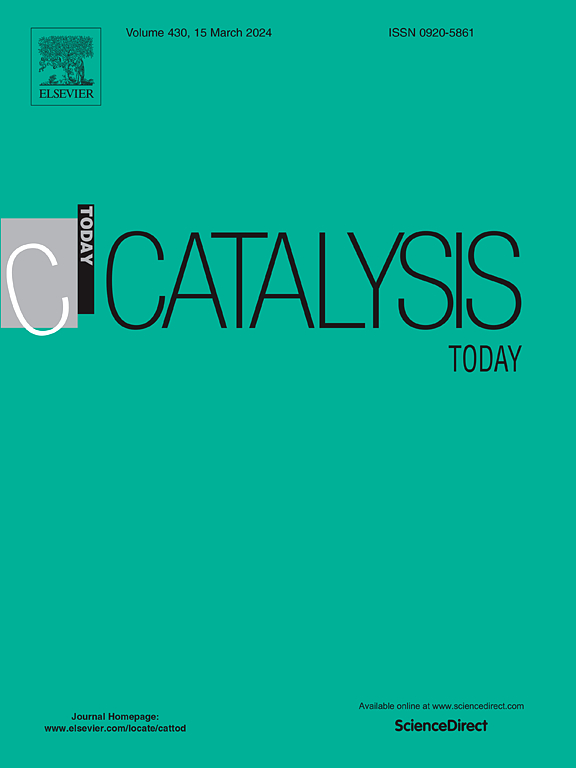Promotion effect of nickel on the stability of NiMnAl catalysts for the PET glycolysis
IF 5.2
2区 化学
Q1 CHEMISTRY, APPLIED
引用次数: 0
Abstract
NiMnAl oxides catalysts obtained from coprecipitated precursors were used in the PET glycolysis depolymerization reaction. These precursors exhibited different phases, including LDH, hausmannite, and rhodochrosite depending on the synthesis conditions. The NiMnAl trimetallic oxides displayed higher surface area and pore diameter than MnAl bimetallic oxide. Sodium-based precipitants formed a more crystalline manganese oxide phase and a higher synthesis yield than the ammonium carbonate/ hydroxide. Catalysts containing a lesser Ni/Mn molar ratio exhibited higher activity for PET glycolysis. The presence of nickel in NiMnAl oxide improved from 49 % to 96 % the catalyst recovery after the reaction. This property relates to a strong electronic interaction between nickel and manganese and the suppressed Jahn-Teller distortion effect. The best catalyst was Ni0,22Mn0,45Al0,33-Sod, reaching 100 % PET conversion and 85 % BHET yield in the following conditions: 60 min, catalyst: PET = 0.5 %, EG: PET = 5:1. This catalyst demonstrated high performance after 5 cycles of reuse without calcination between cycles. Kinetic modeling revealed an initial shrinking core behavior changing to a pseudo-first-order model at the later stage of the reaction.
镍对PET糖酵解NiMnAl催化剂稳定性的促进作用
用共沉淀前驱体制备的镍氧化物催化剂用于PET糖酵解聚反应。这些前驱体根据不同的合成条件表现出不同的相,包括LDH、豪斯曼锰矿和菱锰矿。mnnal三金属氧化物比mnnal双金属氧化物具有更高的比表面积和孔径。与碳酸铵/氢氧化物相比,钠基沉淀剂形成了更结晶的氧化锰相,合成率更高。镍锰摩尔比越小的催化剂对PET的糖酵解活性越高。镍在NiMnAl氧化物中的存在使反应后的催化剂回收率从49 %提高到96 %。这种性质与镍和锰之间的强电子相互作用和抑制的扬-泰勒扭曲效应有关。最佳催化剂为Ni0,22Mn0,45Al0,33-Sod,在60 min,催化剂:PET = 0.5 %,EG: PET = 5:1的条件下,PET转化率达到100 %,BHET收率达到85 %。该催化剂经过5次循环使用后表现出良好的性能,循环之间没有煅烧。动力学模拟表明,反应后期由初始缩核行为转变为伪一阶模型。
本文章由计算机程序翻译,如有差异,请以英文原文为准。
求助全文
约1分钟内获得全文
求助全文
来源期刊

Catalysis Today
化学-工程:化工
CiteScore
11.50
自引率
3.80%
发文量
573
审稿时长
2.9 months
期刊介绍:
Catalysis Today focuses on the rapid publication of original invited papers devoted to currently important topics in catalysis and related subjects. The journal only publishes special issues (Proposing a Catalysis Today Special Issue), each of which is supervised by Guest Editors who recruit individual papers and oversee the peer review process. Catalysis Today offers researchers in the field of catalysis in-depth overviews of topical issues.
Both fundamental and applied aspects of catalysis are covered. Subjects such as catalysis of immobilized organometallic and biocatalytic systems are welcome. Subjects related to catalysis such as experimental techniques, adsorption, process technology, synthesis, in situ characterization, computational, theoretical modeling, imaging and others are included if there is a clear relationship to catalysis.
 求助内容:
求助内容: 应助结果提醒方式:
应助结果提醒方式:


